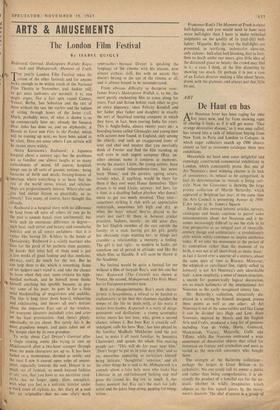ART
De Haut en has
ART Nouveau fever has been raging for over five years now, and far from showing signs of abating it looks as if it will get worse. 'That strange decorative disease,' as it was once called, has turned into a rash of infectious buying from New York to Paris and London to Cologne, in which eager collectors snatch up 1900 objects almost as fast as museums catalogue them into exhibitions.
Meanwhile we have seen some delightful and cunningly constructed commercial exhibitions in London, which consistently prove that pne pf Art Nouveau's most winning charms is its lack of consistency, its refusal to be categorised, in fact its determination to remain a living anti- style. Now the Grosvenor is showing the large private collection of Martin Battersby, which appeared at Brighton last year; at the same time the Arts Council is presenting Amour de 1900: L'Art beige at St. James's Square.
Amid all this revived interest articles, surveys, catalogues and books continue to parrot some misconceptions about Art Nouveau and it be- comes increasingly difficult' to see the style in its true perspective as an integral part of twentieth- century design and architecture--a revolutionary style which subtly continues to inspire aesthetics today. If we take the movement at the period of its conception rather than the moment of its birth, it was not at all short-lived, as many insist : in fact it lasted over a quarter of a century, about the same span of time as Rococo. Moreover, the whiplash or curvilinear line, rightly called its leitmotif, is not Art Nouveau's only identifiable trait : a new simplicity, a sense of innate structure, a search for geometrically logical decoration, are as much hallmarks of the international Art Nouveau as the easily recognised sinewy line.
Mr. Battersby's collection, attractively dis- played in a setting he himself designed, proves these points as well as one other : all Art Nouveau is not of the same calibre and like Camp it can be divided into High and Low. Haut Nouveau, inspired by Morris and the English Arts and Crafts, produced a long list of geniuses including Van de Velde, Horta, Guimard, Mackintosh, \'oysey, Majorelle, Gelid and Tiffany, while Bas Nouveau embraced a wide assortment of decorative objects that relied for invention on fantasy and symbolism and were as varied as the new-rich customers who bought them.
The strength of the Battersby collection--- perhaps the largest in Great Britain—is its catholicity. No one could call its owner a purist and rather than being comprehensive, it is ob- viously the product of a fanciful eye for the un- usual, whether in wildly imaginative kitsch objects or the fine signed pieces by the move- ment's masters. The chef d'oeuvre is a group of English silverware that argues that the British contribution to the style not only rested in its beginnings in the 'eighties, but was carried on with craftsmanship and inventive design up till the First World War. If Mr. Battersby% col- lection fails to be academically orientated, this is in fact its success, since it gives a wider picture of the febrile search for original design at the turn of the century than other exhibitions to date which have been ground through the sieve of scholarly selectivity And here is the major fault with Autour de 1900: L'Art beige, for in its attempt to put its fin de siecle in order, the Belgian Ministry of Education and Culture has turned out a dry and dusty gathering of Brussels' most interesting Art Nouveau talents. Thus, towering figures such as Van de Velde, Horta, Pankok and Wolfers are relegated to a few blown-up photographs and a showcase of objects. Moreover, painters such as James Ensor, Georges Lemmen and Felicien Rops, all of them outstanding artists, are repre- sented not by major works. but by pictures that are supposed to prove some tired point of reference to Belgium's connection with French Post-Impressionists, Symbolism, and the English Pre-Raphaelites.
It was as a result of the critic Octave Maus's far-sighted institution of Les Vingt in Brussels in 1884 that Seurat, Degas and Van Gogh were brought to the attention of the public. But it was his founding of La Libre Esthetique in 1893 that
ti turned attention toward the English Arts and Crafts, which perhaps was not a bad thing seeing how those poor artists suffered under a pains- taking dot technique inspired by Seurat. In any event, it meant that Van de Velde gave up pointillist oils to become one of the most im- portant designers and architects of the twentieth
century. • Belgian painting of this period will probably always seem derivative of Paris styles, but it certainly was not nearly as lacking in inspiration as it is made to look here. Even artists such as Xavier Mellery and Fernand Khnopff, who are at the root of the Belgian Surrealist school, are only tantalisingly represented by a couple of works each. Georges Minne alone, whose gently angular figures are put together with Art Nouveau's well-modulated curves, is well repre- sented: these sensitive bronzes remind us that a full-scale exhibition of his work is long overdue.
Taken as a whole the Arts Council show neither gives us a whiff of 1900 as its title implies, nor does it do its artists justice. It has been too deodorised into dullness by the arid process of categorised art history.
MARIO AMAYA



































 Previous page
Previous page